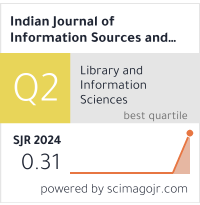Use of E-journals by Post Graduate Students at Government First Grade College at Kolar, Karnataka
DOI:
https://doi.org/10.51983/ijiss.2017.7.1.460Keywords:
E-journals, postgraduate students, government First Grade colleges, electronic resourcesAbstract
Journals constitute an important part of a library collection being the most important vehicle for global scholarly communication. Tremendous developments in ICT in the recent years have given amazing boost to electronic publishing. As a result the information which is being generated at intense pace from all the directions world-wide for all the themes is now being published in form of electronic journals (e-journals). Anyone with access to a computer equipped with a modem and suitable software can produce and distribute an e-journal through a computer network, thus journal publishing is being democratized. Usually, e-journals are published as electronic equivalents of their print counterparts but recently there is an increase in number of scholarly journals which are being published only electronically. As a result, e-journals have emerged as vital components of information resources of a library and play an imperative role in the distribution of prime information. E-journals have been defined in different ways by different authors.
References
Afolabi, M. O. (2007, October 18). Electronic Information for Libraries Network (Elfl.net) [Workshop notes]. Obafemi Awolowo University.
Akpochafo, W. P. (2009). Revitalizing research in Nigerian Universities for national development. Educational Research and Review, 4(5), 247-25.
Alasa, M., & Kalechukwu, I. (1999). Internet and academic library services development in Nigeria. Nigerian Libraries, 33(1), 17-35.
Ali, N. (2005). The use of electronic resources at IIT Delhi library: A study of search behavior. The Electronic Library, 23(6), 691-700.
Ayoo, P. O., & Lubega, J. T. (2014). A framework for e-learning resources sharing (FeLRS). International Journal of Information and Education Technology, 4(1), 112-119.
Deng, H. (2010). Emerging patterns and trends in utilizing electronic resources in higher education environment: An empirical analysis. New Library World, 111(3/4), 87-103.
Dilek-Kayaoglu, H. (2008). Use of electronic journals by faculty at Istanbul University, Turkey: The result of a survey. Journal of Academic Librarianship, 34(4), 239-247.
Gardner, S. J., Juricek, J. C., & Xu, F. G. (2008). An analysis of academic libraries web pages for faculty. Journal of Academic Librarianship, 34(1), 16-24.
Hamade, S. N., & Al-Yousef, S. (2010). The use of information resources by LIS graduate students in Kuwait. Library Review, 59(5), 360-369.
Ndinoshiho, H. M. (2010). The use of electronic information services by undergraduate nursing students at the University of Namibia’s Northern campus: A descriptive study. Information Development, 26(1), 57-65.
Okello-Obura, C., & Magara, C. (2008). Electronic Information access and utilization by Makerere students in Uganda. Library and Information Practice, 3(3), 39-56.
Okon, E. A. (2010). Internet access and use: A study of undergraduate students in three Nigerian universities. Electronic Library, 28(4), 555-567.
Ollé, C., & Borrego, A. (2010). Librarians’ perception on the use of electronic resources at Catalan academic libraries: Results of a focus group. New Library World, 111(1/2), 46-54.
Downloads
Published
How to Cite
Issue
Section
License
Copyright (c) 2017 The Research Publication

This work is licensed under a Creative Commons Attribution-NonCommercial-NoDerivatives 4.0 International License.









